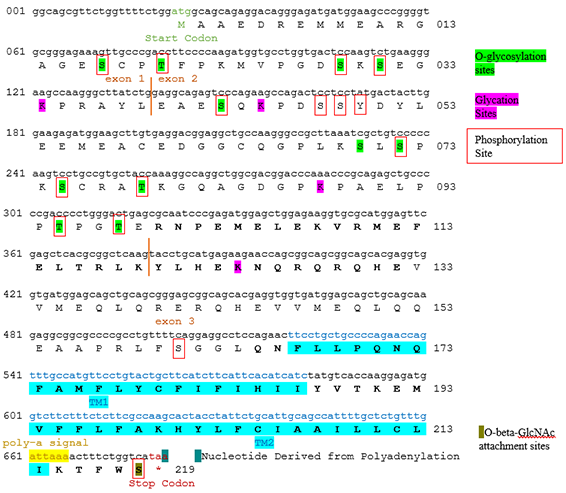| Matrix | Detailed matrix information | Anchor base | Strand | Matrix similarity | Sequence |
|---|
| V$TBX5.01 | Brachyury gene, mesoderm developmental factor | 1040 | (+) | 1 | ctacctcaaaGGTGtcacaccctccacca |
| V$EOMES.03 | Brachyury gene, mesoderm developmental factor | 1042 | (-) | 0.987 | tttggtggagggTGTGacacctttgaggt |
| V$PDEF.01 | Human and murine ETS1 factors (Prostate-derived Ets Factor) | 998 | (-) | 0.974 | gaactgcaGGATgggcctttg |
| V$RFX3.01 | X-box binding factors | 1064 | (+) | 0.974 | aaggggccctagCAACttg |
| V$SPZ1.01 | Testis-specific bHLH-Zip transcription factors (Spermatogenic Zip 1 transcription factor) | 1046 | (-) | 0.966 | tGGAGggtgtg |
| V$TBX20.02 | Brachyury gene, mesoderm developmental factor | 1149 | (-) | 0.939 | catcatttgaggtgctGACAtttggcctc |
| V$HSF1.05 | Heat shock factors | 1198 | (-) | 0.938 | ctgctgccatCCAGaaaaccagaac |
| V$MYOD.01 | Myogenic regulatory factor MyoD (myf3) | 1178 | (-) | 0.919 | cgctGCCAggtggggtc |
| V$MTBF.01 | Human muscle-specific Mt binding site | 1128 | (+) | 0.906 | tggaATCTg |
| V$RFX3.02 | Regulatory factor X, 3 (secondary DNA binding preference) | 1278 | (+) | 0.889 | gatggtgcctgGTGActcc |
| V$OCT3_4.02 | Motif composed of binding sites for pluripotency or stem cell factors | 892 | (+) | 0.882 | acaatctTCATttaaaaaa |
| V$HSF1.01 | Heat shock factors | 1190 | (-) | 0.845 | atccagaaaaccAGAAcgctgccag |
| V$EN1.01 | Homeobox transcription factors | 897 | (-) | 0.832 | gttcctttTTTAaatgaag |
| O$XCPE1.01 | Activator-, mediator- and TBP-dependent core promoter element for RNA polymerase II transcription from TATA-less promoters | 1243 | (+) | 0.831 | gtGCGGgagaa |
| V$DICE.01 | Downstream Immunoglobulin Control Element, critical for B cell activity and specificity | 1091 | (-) | 0.827 | tgtcGTCAtcatagc |
| V$ISL1.01 | Lim homeodomain factors | 1012 | (+) | 0.827 | tgcagttctTAATgttagcatgt |
| V$RFX4.03 | X-box binding factors | 1064 | (-) | 0.814 | caaGTTGctagggcccctt |
| V$EN1.01 | Homeobox transcription factors | 922 | (+) | 0.788 | aaatggatTTCAaatggtg |
| V$SOX9.03 | SOX/SRY-sex/testis determining and related HMG box factors | 1061 | (+) | 0.786 | caCCAAaggggccctagcaactt |
| V$OSNT.01 | Composed binding site for Oct4, Sox2, Nanog, Tcf3 (Tcf7l1) and Sall4b in pluripotent cells | 1151 | (+) | 0.784 | aatgtcaGCACctcaaatg |
| V$PROX1.01 | Prospero-related homeobox | 1163 | (+) | 0.783 | aatGATGtcttgt |
| V$SOX9.03 | SOX/SRY-sex/testis determining and related HMG box factors | 975 | (+) | 0.781 | ttTCAAagccatccttatgggca |
| V$HSF2.03 | Heat shock factors | 1075 | (+) | 0.777 | ctagcaacttgtAGAAtgtaggcta |
| V$HSF5.01 | Heat shock factors | 1074 | (-) | 0.764 | agcctacatTCTAcaagttgctagg |









